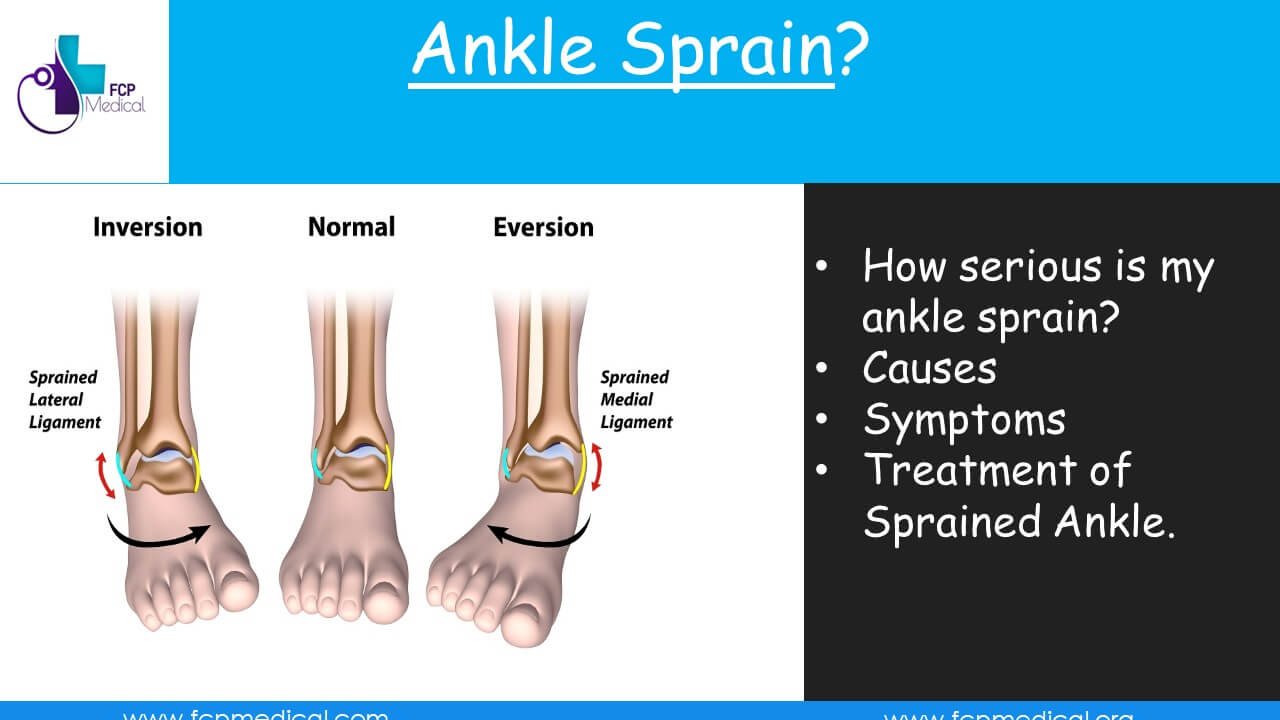
Ankle sprain is the most common injury worldwide in both athletes and non-athletes.
On this page: -
Mechanism Of Ankle Sprain
Ankle sprain is caused by the sudden twisting or awkward movement of the foot while walking or running on uneven surface, usually during sports activities such as playing football, volleyball, or soccer. Consequently, ligaments around the ankle joint are damaged to varying degree depending on the severity of the injury. As a result, patient develops pain and swelling around the ankle joint.
In ankle sprain, following ligaments are stretched or torn depending on the severity of the injury: -
Sign and Symptoms of the ankle sprain
The sign and symptoms depend on the severity and extent of the injury. The most common symptoms are following: -
Types of the Ankle Sprain
There are two main types of the ankle sprain according to the mechanism of the injury: -
Inversion Ankle Sprain
This is the most common type of the ankle sprain. Inversion Ankle Sprain occurs when foot is twisted inwards, causing damage to the Anterior talofibular ligament and Calcaneofibular ligament. The patient feel pain on the outer or lateral side of the ankle.
Can you walk with ankle sprain? It depends on the grade of the ankle sprain as discussed below.
Grading of the Ankle Sprain
There are three grades of the ankle sprain depending on the severity of the injury: -
In Grade-1 ankle sprain, Anterior talofibular ligament is stretched with minimal injury or damage. Therefore, patient can full weight bear and does not require walking aids. However, they may not be able to jump or do jogging. Pain and swelling are the main symptoms in this category.
In Grade-2 ankle sprain, there is partial injury of the Anterior-talofibular ligament.
The patient present with pain, significant swelling and bruising around the ankle joint. Patient feel pain while walking but can walk for few steps.
In Grade-3 ankle sprain, there is complete rupture of the Anterior talofibular ligament and Calcaneofibular ligament.
The patient presents with severe pain, swelling and bruising around the ankle joint. There may be loss of range of motion and patient will be unable to bear weight or walk.
The patient feels ankle instability or giving way and requires walking aid.
Eversion Ankle Sprain
Eversion Ankle Sprain occurs when foot is twisted outwards causing damage to the medial or the Deltoid ligament. The patient feel pain on the inner or medial side of the ankle joint.
High Ankle Sprains
The ligament that unit tibia and fibula (bones of the lower legs) together is called as Syndesmosis. High ankle sprains involve injury to this ligament.
Diagnosing the Ankle sprain
Diagnosis of the ankle sprain is based on the history and physical examination. Usually, x-rays are not recommended but in certain cases radiographs are indicated to rule in or rule out fracture based on the Ottawa ankle rule.
Treatment of the ankle sprain
In the first 24-48 hours of injury, the treatment of ankle sprain is started with RICE method: -
Depending on the grade of the ankle sprain, patient may require walking aid (crutches or a walking stick) and a course of physiotherapy.
There are certain therapeutic exercises that patient needs to do to improve mobility and strengthening.
Delayed or untreated cases remains symptomatic for a long period of time and hence require extensive course of treatment. Therefore, it is recommended to seek expert advice as soon as possible when someone develop ankle sprain.
When to Seek Advice if you Sprained Your Ankle?
For advice, contact to our specialists.
Links:
You may also be interested in :-
Author Information
The healthcare professionals write our blogs to provide useful information for the patients and public. The author of this blog post is: -
Dr Fouzia Bashir, PhD, MSC ACP.
Consutant Physiotherapist | Independent Medicine Prescriber
Comments List